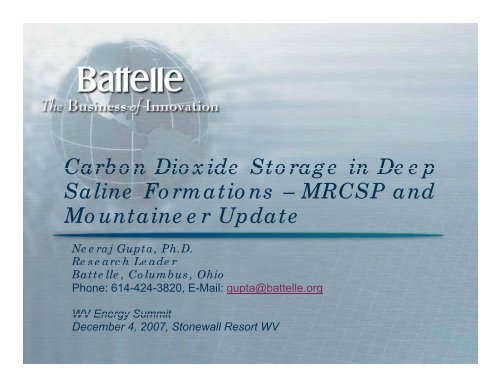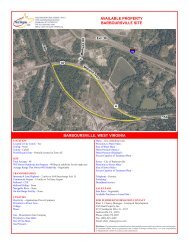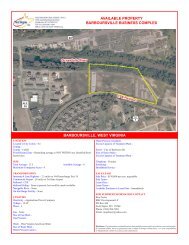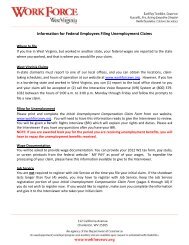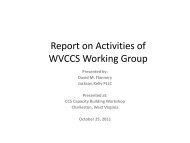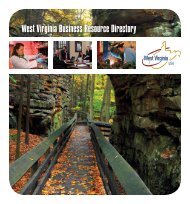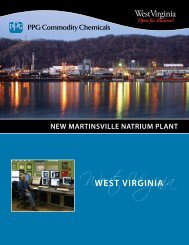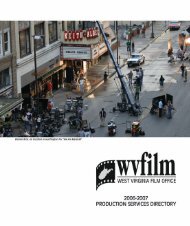Carbon Dioxide Storage in Deep Saline Formations - West Virginia ...
Carbon Dioxide Storage in Deep Saline Formations - West Virginia ...
Carbon Dioxide Storage in Deep Saline Formations - West Virginia ...
You also want an ePaper? Increase the reach of your titles
YUMPU automatically turns print PDFs into web optimized ePapers that Google loves.
<strong>Carbon</strong> <strong>Dioxide</strong> <strong>Storage</strong> <strong>in</strong> <strong>Deep</strong>Sal<strong>in</strong>e <strong>Formations</strong> – MRCSP andMounta<strong>in</strong>eer UpdateNeeraj Gupta, Ph.D.Research LeaderBattelle, Columbus, OhioPhone: 614-424-3820, E-Mail: gupta@battelle.orgWV Energy SummitWV Energy SummitDecember 4, 2007, Stonewall Resort WV
Battelle Plays a Key Role <strong>in</strong> Several<strong>Carbon</strong> Sequestration InitiativesMounta<strong>in</strong>eerFutureGenRegional Reservoir Characterization“Piggyback Drill<strong>in</strong>g”Global l EnergyTechnology StrategyProgram (GTSP)
Mounta<strong>in</strong>eer Plant, <strong>West</strong> Virg<strong>in</strong>ia, USA –Funded by DOE-AEP-BP-Battelle-OCDO-Schlumberger etc.• 1300 MW pulverized coal plant withNOx and SOx control• An area of <strong>in</strong>tense powerproduction and future expansion• AEP has announced a major scaleupand a multi-pronged CCSdeployment at this and other sites.
Site-Specific CharacterizationEssential for Safe and Effective OperationsSeismic SurveyDrill<strong>in</strong>g Test WellPossiblestorageformations> 2,500 ft deepGroundlevel9,000 feetbelow thesurface
nta<strong>in</strong>eer Site - Seismic Survey Demonstratedact of Plant Noise and Lack of Fault<strong>in</strong>g
2 Injectivity <strong>in</strong> the Mounta<strong>in</strong>eer Areanumber of geologic formations have been evaluated for CO 2 storagetential <strong>in</strong> the Ohio River Valley region through Mounta<strong>in</strong>eer projectCO 2 <strong>in</strong>jection should also bepossible <strong>in</strong> shallower sandstoneand carbonate layers <strong>in</strong> the regionRose Run Sandstone (~7800 feet)is a regional candidate zone <strong>in</strong>Appalachian Bas<strong>in</strong>A high permeability zone called the“B zone” with<strong>in</strong> Copper RidgeDolomite has been identified as anew <strong>in</strong>jection zone <strong>in</strong> the regionMount Simon Sandstone/BasalSand - the most prom<strong>in</strong>entreservoir <strong>in</strong> most of the Midwest
lat<strong>in</strong>g Geologic Sequestration to support permitt<strong>in</strong>g, outreach,and Facility DesignStochasticSimulationsMultiple Injectors<strong>Carbon</strong>ate ReservoirsWater, CO2, Salt
nta<strong>in</strong>eer CO 2 <strong>Storage</strong> Assessment Project - Aque Public Private Collaboration<strong>in</strong>ce 2002, a number of organizations and experts have contributed<strong>in</strong>ancially (>$7M) and technically <strong>in</strong> evaluat<strong>in</strong>g geologic sequestrationeasibility at the Mounta<strong>in</strong>eer Plant:– Battelle Memorial Institute t – Lead performer and co-sponsor– DOE/NETL – Primary f<strong>in</strong>ancial support– AEP – Host site and co-sponsor– Ohio Coal Development Office– BP– Schlumberger– Ohio Geological Survey– Regional Geologists– Stanford’s GCEP Program– CO 2 Capture and handl<strong>in</strong>g Companies– Regional Oil and Gas Companies– CRIEPI (Japan)– Midwestern Regional <strong>Carbon</strong> Sequestration Partnership (MRCSP)
dwestern Regional <strong>Carbon</strong>questration Partnership (MRCSP)U.S. Department of Energy/NETL
RCSP’s mission is to be the premier resource forstration knowledge <strong>in</strong> its regionn Four Americansf U.S. Electricity - ¾ From CoalMillion Tons of CO 1202 /yearLarge Po<strong>in</strong>t Sources of CO 2100806040200Net Sequestra ation-Based EmissionsAbatement Costs ($/tonne CO 2 )Phase IDevelop<strong>in</strong>g a Regional Model of theEconomics of SequestrationGeologicTerrestrialImplementationPhase II0 250 500 750 1000Annual Supplied CO 2 Sequestration Capacity (MtCO 2 )Reach<strong>in</strong>g Out To andEducat<strong>in</strong>g StakeholdersQuantify<strong>in</strong>g CO 2 S<strong>in</strong>ks <strong>in</strong> the RegionGeologicalsp.orgTerrestrial:• Potential for 20%annual offset forlarge po<strong>in</strong>t sourcesGeologic:• 100s of years ofcapacity for largepo<strong>in</strong>t sources <strong>in</strong> deepsal<strong>in</strong>e aloneTerrestrial
estrial Sequestration –ee field projects be<strong>in</strong>g pursuedCroplandsReclaimed M<strong>in</strong>elands
Data from over 40,000SP Region’s Vast Geological <strong>Storage</strong> Potentialell Positioned Relative to Sourcessal<strong>in</strong>e formations:Depleted oil and gas fields00,000 MMTCO 2 ~1,400 MMTCO 2Unm<strong>in</strong>eable coal and shale~350 MMTCO 2
logic <strong>Storage</strong> – three sites are be<strong>in</strong>gracterized for <strong>in</strong>jection tests by MRCSPigan Bas<strong>in</strong>Appalachian Bas<strong>in</strong>nnati Arch
Phase II geologic g field efforts are underwayMichigan Bas<strong>in</strong> SiteAppalachian Bas<strong>in</strong> Sitehio <strong>Deep</strong> WellC<strong>in</strong>c<strong>in</strong>nati Arch Site
2 <strong>Storage</strong> Model<strong>in</strong>g Processeptualize-characterize-Design-Monitor-Calibrateateperience with MRCSP and other projects hasonstrated the value of site specific data from test wells.xample- MRCSP Michigan Bas<strong>in</strong> State-Charlton 30/31 Field Test Site<strong>in</strong>ary Model<strong>in</strong>g Site Drill<strong>in</strong>g and Test<strong>in</strong>g Site Specific Model<strong>in</strong>gn Regional Data
posed Phase III Geologic Test Sitesthanola IGCC• Primary site– Injection starts <strong>in</strong> earlyFY2010– Plans are to <strong>in</strong>ject 1 milliontons of CO 2 over a four-yearperiod– Target is the Mt. Simonreservoir, the largest deepsal<strong>in</strong>e target <strong>in</strong> our region.• Optional site– Injection starts <strong>in</strong> FY 2012– Possible 2 million tons of<strong>in</strong>jection over four-year<strong>in</strong>jection period
titutional/Regulatory Aspectsegulatory framework is emerg<strong>in</strong>g for deep wellection through extensive <strong>in</strong>teractions with federald state authorities under ongo<strong>in</strong>g projects.wever, the agencies need the resources andndate to expedite regulatory framework.blic utility commissions and policymakers arecom<strong>in</strong>g <strong>in</strong>creas<strong>in</strong>gly gy aware of the technical andonomic issues related to CCS.rough Regional Partnerships and FutureGencess several states have considered long-termbility and ownership issuesere is a strong need for faster progress on theseere is a strong need for faster progress on theseues as we move towards large-scale test<strong>in</strong>g
mary of Trends – We are Now <strong>in</strong> atical Phase for Future Success of CCSr<strong>in</strong>g last few years, CCS has attracted grow<strong>in</strong>gerest and support from regional <strong>in</strong>dustry andlicymakers, this momentum must cont<strong>in</strong>ueerg<strong>in</strong>g Issues:A major effort to expedite capture technology developmentand <strong>in</strong>tegrated capture and storage demonstrationsRegional plann<strong>in</strong>g for transport and storage networksDevelop<strong>in</strong>g regulatory, policy, and risk managementframework <strong>in</strong> parallel l with large-scale l test<strong>in</strong>gtiBuild<strong>in</strong>g public acceptance as we proceed todeployment
nk you!Drill<strong>in</strong>g at AEP Mounta<strong>in</strong>eer Plant, <strong>West</strong> Virg<strong>in</strong>ia


